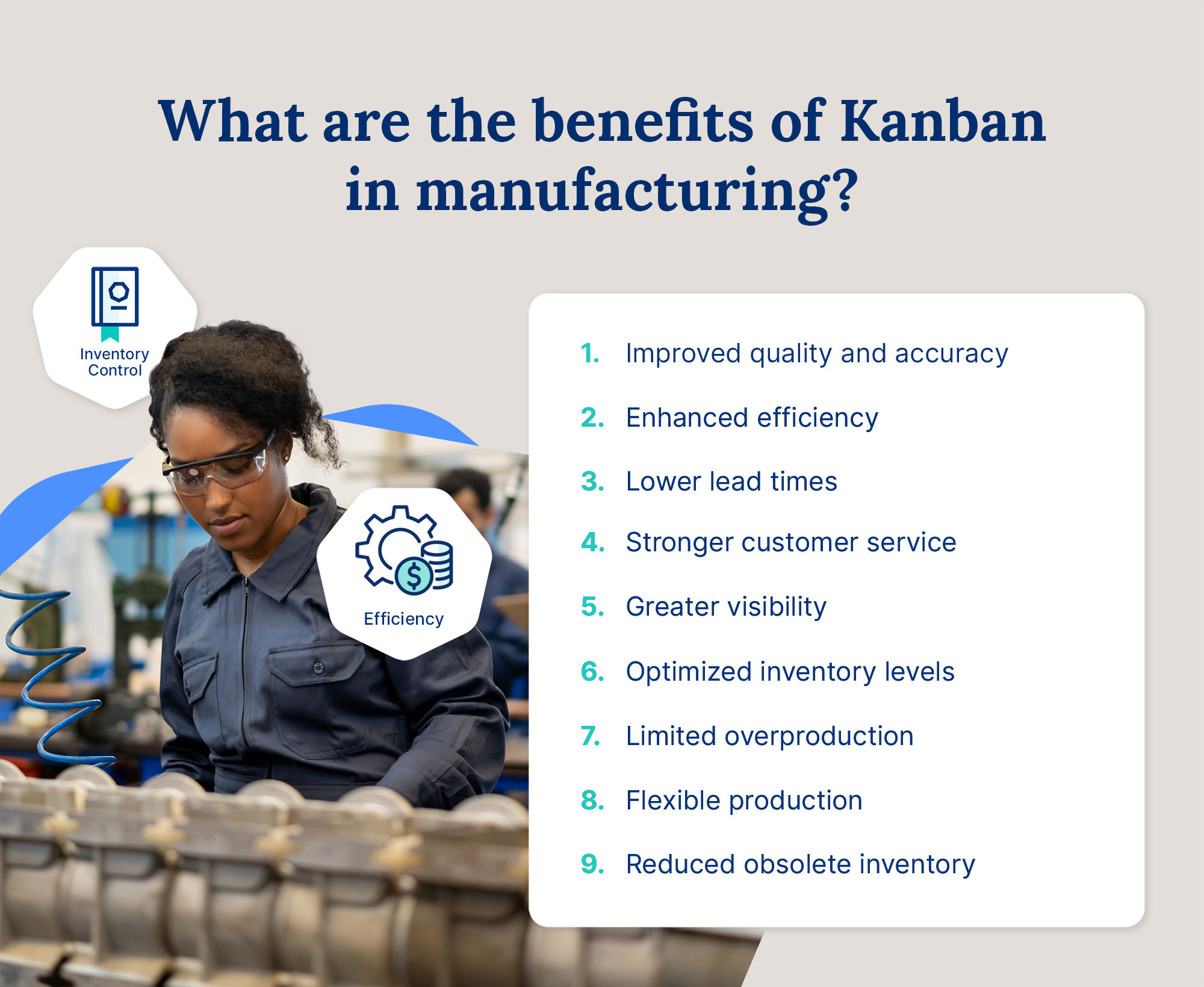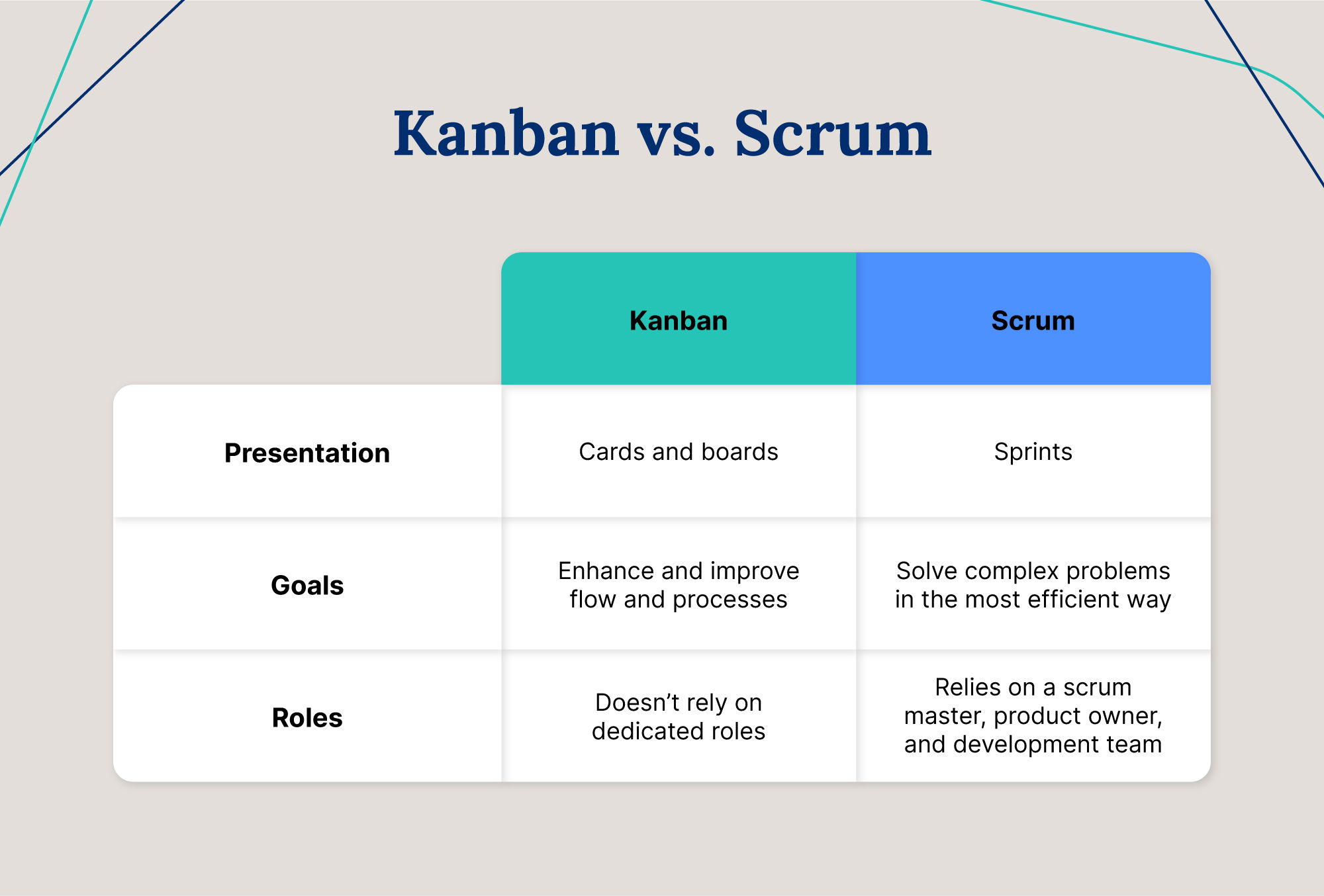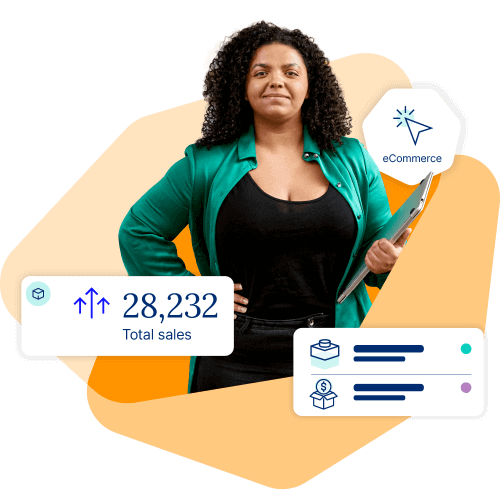

Think of Kanban in manufacturing like loading a dishwasher. When done correctly, everything fits perfectly and gets cleaned efficiently. And just as you wouldn’t overload a dishwasher or mix up different types of dishes, Kanban prioritizes specific manufacturing tasks so that you can complete them efficiently and effectively.
Originating as a manufacturing process, Kanban now broadly ensures that teams can work together seamlessly towards a common goal. Whether optimizing warehouse management systems or creating centralized supply chain management, Kanban can be instrumental in removing inefficiencies from workflows.
But what exactly is Kanban, and how can you integrate it? In this post, we’ll explore what Kanban is, the benefits of implementing it into your workflows, and a few real-world examples of companies that have leveraged Kanban’s capabilities to create seamless processes — just like a perfectly loaded dishwasher.
Kanban describes a method of inventory control companies use to make smarter reordering decisions and track production more easily. The term “Kanban” came into existence almost 50 years ago when Taiichi Ohno, an engineer at Toyota Automotive, developed the first Kanban system to improve manufacturing efficiency.
The four core principles of Kanban are:
The idea of Kanban was taken from an unlikely inspiration: a supermarket. Toyota noticed that supermarkets restocked an item according to the store’s supply and not the vendor’s. Supermarkets replenished items only when they were nearly out of stock.
The grocers’ ‘just in time’ inventory method and delivery process sparked an interest in Toyota to adopt a similar approach where inventory matched demand.
Kanban systems in manufacturing communicate the need to replenish stocks or produce an item. When it comes to producing items, Kanban breaks down the process into defined steps to ensure production is done efficiently and without error. The process is defined by the steps below:

Kanban typically breaks down into six main types: production, withdrawal, supplier, emergency, through, and express. Different types of Kanbans serve a specific purpose and help solve various problems in inventory management, like ensuring tasks are completed efficiently and materials aren’t going to waste.
Production Kanban is the simplest and most widely used method of Kanban — and it applies to almost every industry. This method creates production cards, which illustrate the raw materials and processes necessary to create a product.
Withdrawal Kanban ensures that time and labor are used as efficiently as possible. In this method, floor staff use withdrawal cards to signify that a process or task is finished and they are ready for the next one. The card additionally signals that their component is complete and ready to move to the next production stage.
For industries that rely heavily on supplier collaboration, supplier cards allow suppliers greater visibility into the production process and to be part of the larger Kanban system. This streamlines the process by reducing the time it typically takes to make a supplier request.
While Kanban strives to prepare for the unexpected, emergencies are inevitable in an organization. Emergency Kanban cards are reserved for situations where a defective part needs to be quickly replaced to restore the system to its natural flow.
You will use Through Kanban cards, a combination of production and withdrawal cards, when two different production teams work in tandem in the same setting. Instead of using both a production and withdrawal card to signal a task is complete and another is ready to begin, a through card accomplishes both.
Express Kanban serves the sole purpose of alerting team members when manufacturers are short of specific items or materials. Using express Kanban ensures manufacturers never experience slowdowns due to raw material—or other item—shortages.
Implementing Kanban into your inventory management techniques can benefit your internal processes and your relationship with customers and suppliers in major ways. Here are nine major upsides to adopting Kanban.

By outlining processes before they begin, companies can foresee and predict potential roadblocks during production. By identifying these ahead of time, manufacturers can adequately navigate around them to reduce delays and improve overall quality.
A core principle of Kanban is reducing manufacturing waste, which can mean eliminating processes or steps that have no value to the customer. By taking away unnecessary steps, manufacturers can work more efficiently and produce products quickly.
When you cut out the wasteful steps in a process, you can guarantee lower lead times. Kanban allows businesses to get products to customers faster and can therefore lower costs. By examining each step of the production process under a microscope, companies can reduce carrying costs, package quicker, and move products more efficiently.
Kanban relies on continuous feedback and improvement, which emphasizes customer service and customer feedback. Additionally, Kanban allows you to be on top of processes — meaning you’re always engaging with customers and meeting their needs quickly.
Visibility and transparency are at the heart of the Kanban process, and the system seeks to allow stakeholders to visualize the flow of products and information easily. By adopting a process all team members can easily see how to prioritize tasks — making for more efficient workflows.
Since inventory is not replenished until needed, Kanban reduces the need for additional storage space and prevents cash flow from being tied up in excessive inventory. Kanban enables maintaining accurate inventory levels in real time.
Kanban is a demand-pull system, meaning it pulls work from the previous stage according to the designated need for production. Kanban adheres to just in time inventory principles, eliminating the need to keep too much safety stock to deal with unexpected delays during the production line.
A Kanban inventory control system focuses on current demands to set production capacity appropriately. If there is a sudden surge in demand for a product, Kanban ensures the minimum possibility of excess inventory, giving the production process flexibility in responding to changing demands.
Kanban also provides adaptability to the production line as you can easily switch it to different products depending on the demand.
Even if a product or component design needs upgrades, it is incorporated into the final product as soon as possible. No component goes wasted or becomes obsolete inventory.
Additionally, since you’re operating under the just in time inventory technique, you’re less likely to be stuck with excess inventory if demand shifts unexpectedly.
In manufacturing, Kanban can be extremely effective in enhancing efficiency and improving processes, but fully adopting it into your inventory management process can be easier said than done. Here’s why:
Achieving inventory flow involves your processes being balanced, meaning that if you adopt Kanban, it needs to work alongside your inventory management technique. Since Kanban prioritizes limiting waste, it works well with just in time inventory management.
Depending on your inventory management technique, which likely depends on your industry, you’ll need to carefully evaluate if Kanban is feasible for your current inventory processes.
Request a demo of Cin7 to see how Connected Inventory Performance can improve and automate your inventory processes.
Kanban can be extremely rewarding and significantly benefit an organization, but it can be difficult to encourage team members to adopt Kanban.
When you adopt Kanban, you may be up-ending an established process, so don’t be surprised if you experience resistance from team members.
Kanban works well to ensure it accounts for fluctuations in demand, but it can be difficult to implement if demand is regularly shifting. While the system can successfully combat unexpected periods of demand, you may experience challenges implementing it during periods of demand fluctuation.
It can also be difficult to maintain low WIP limits when demand is regularly shifting.
While Kanban and Scrum both work to enhance efficiency and create better products, they have slightly different purposes in workflows.
Scrum is an agile method that breaks up work into sprints, or dedicated periods for accomplishing tasks. Kanban and Scrum work well in tandem since they want to achieve the same goal but do so differently. The table below breaks down the major differences between Kanban and Scrum.

Kanban is popular today because it’s a proven system for success. Let’s explore some case studies of companies that leveraged Kanban to see major growth.
Toyota adopted Kanban to their existing system to more easily visualize steps in the engineering process. The aim behind Toyota’s adoption of Kanban was to align their inventory levels with actual demand.
In Toyota’s system, a Kanban card was passed every time a bin of materials was emptied. This action signified to the warehouse how much stock needed to be replenished. As a result, Toyota was able to limit excess inventory in the production line and enable smoother communication between teams.
Nike’s adoption of Kanban stemmed from bad PR after word of poor working conditions in their factories spread. To improve conditions at their factories and mend relationships between staff and management, Nike implemented the pull strategy, which allowed employees to:
Through Kanban, Nike was able to maintain their focus on innovation while simultaneously improving the quality of their working environment.
While the companies above are mammoths now, they were up-and-comers when they initiated the Kanban method. Growth-focused small businesses can see major benefits from Kanban, as the method can eliminate setbacks that tend to stunt growth — like losing capital to excess inventory and failing to optimize internal processes.
Small businesses are always looking for continuous improvement, regardless of whether they’ve implemented Kanban. Visualizing your workflows early on is the best way to pinpoint inefficiencies and find solutions.
Still wondering what Kanban can do for you and your organization? Look no further. Here are a few of the most common questions and answers about Kanban in manufacturing.
The four core principles of Kanban are:
Together, these principles strive to achieve Kanban’s goal of increasing efficiency and reducing waste.
When it comes to raw materials, Kanban ensures that the company only has the necessary amount of raw materials on hand at a given time — limiting the potential for waste.
In inventory management, this is best described as just in time inventory, or the idea that a company should only produce the necessary inventory to meet current customer demand.
Kanban is a method that exists within the Agile methodology. The Agile methodology broadly refers to a systematic approach to creating efficient processes prioritizing continuous improvement.
David Anderson, a pioneer of the Kanban method, described the five elements of Kanban as:
These five elements are all components of Kanban boards and work together to ensure processes go smoothly.
If you want cleaner dishes, you may have to reevaluate the way you load your dishwasher. Creating the most efficient internal systems is a bonafide path to success when it comes to growing a business — and it starts with how you manage inventory. Kanban works hand in hand with your inventory management technique, as the two processes can limit wasted time and wasted stock.
By automating your processes with comprehensive inventory management software, you’ll gain insights into whether Kanban makes sense for your business and where you can improve your inventory efficiency.
Start a free trial of Cin7 to streamline your processes today.


If you’ve been hanging around the accounting department, chances are you’ve heard the term cost of goods sold (COGS) thrown around a few times. But while COGS is important, it’s also a concept people tend to misunderstand. Knowing what COGS is will help you better understand all of the costs associated with your product and […]

Manufacturing lead time is the time it takes to manufacture a product and then deliver it to a customer. In a nutshell, it reflects how long the customer needs to wait to receive what they ordered. We all know the excitement of waiting for a package to arrive — and the confusion and disappointment when […]

A bill of materials (BOM) is an extensive list of raw materials and components required to manufacture or repair a product or service. BOMs are designed in a format that keeps the finished product at the highest level and the other individual components and materials at the bottom. Ever been halfway through making a pizza […]